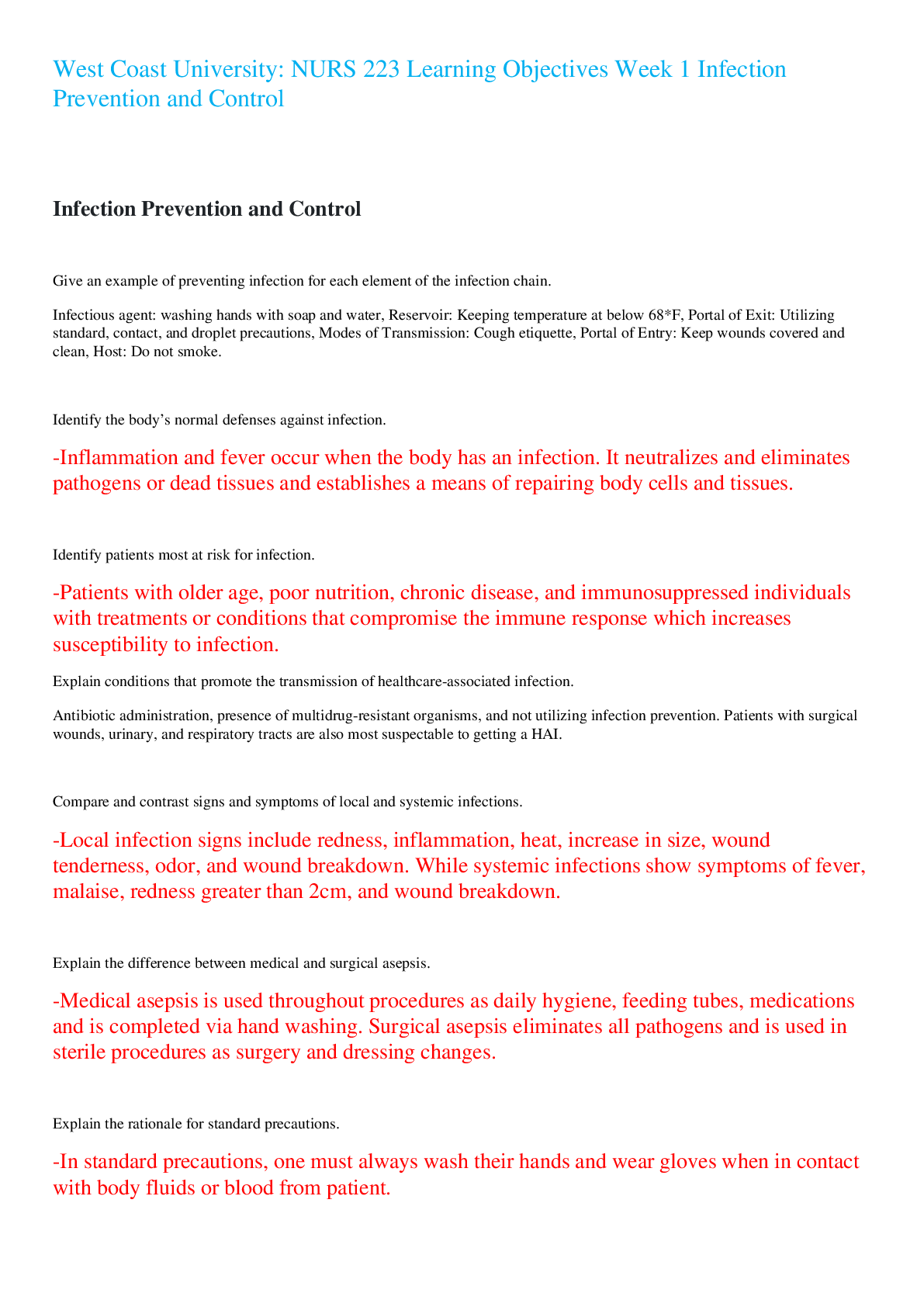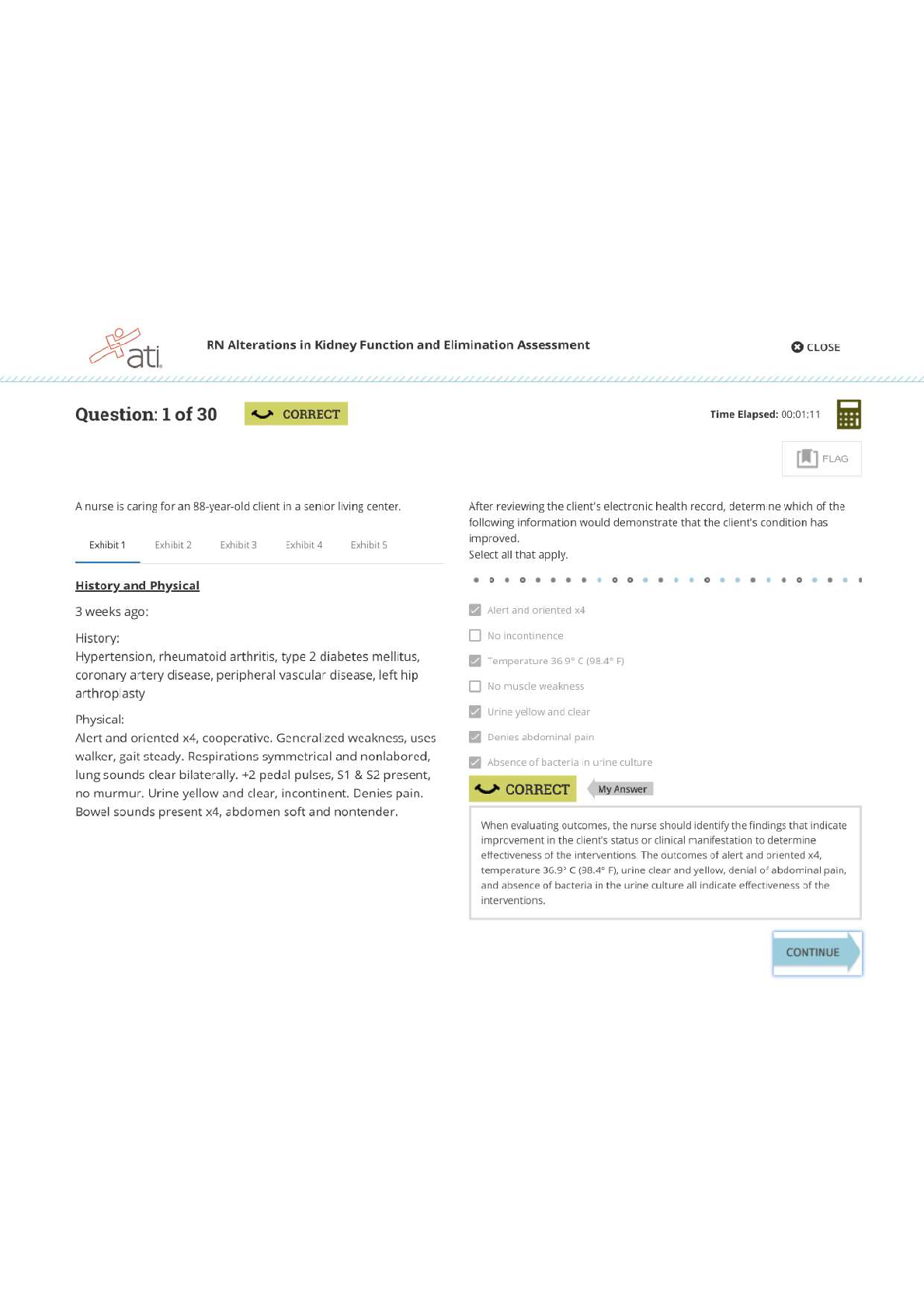*NURSING > EXAM > West Coast University: NURS 223 Learning Objectives Week 1 Infection Prevention and Control,100% COR (All)
West Coast University: NURS 223 Learning Objectives Week 1 Infection Prevention and Control,100% CORRECT
Document Content and Description Below
West Coast University: NURS 223 Learning Objectives Week 1 Infection Prevention and Control Infection Prevention and Control 1. Give an example of preventing infection for each element of the ... infection chain. - Infectious agent: washing hands with soap and water, Reservoir: Keeping temperature at below 68*F, Portal of Exit: Utilizing standard, contact, and droplet precautions, Modes of Transmission: Cough etiquette, Portal of Entry: Keep wounds covered and clean, Host: Do not smoke. 2. Identify the body’s normal defenses against infection. -Inflammation and fever occur when the body has an infection. It neutralizes and eliminates pathogens or dead tissues and establishes a means of repairing body cells and tissues. 3. Identify patients most at risk for infection. -Patients with older age, poor nutrition, chronic disease, and immunosuppressed individuals with treatments or conditions that compromise the immune response which increases susceptibility to infection. 4. Explain conditions that promote the transmission of healthcare-associated infection. - Antibiotic administration, presence of multidrug-resistant organisms, and not utilizing infection prevention. Patients with surgical wounds, urinary, and respiratory tracts are also most suspectable to getting a HAI. 5. Compare and contrast signs and symptoms of local and systemic infections. -Local infection signs include redness, inflammation, heat, increase in size, wound tenderness, odor, and wound breakdown. While systemic infections show symptoms of fever, malaise, redness greater than 2cm, and wound breakdown. 6. Explain the difference between medical and surgical asepsis. -Medical asepsis is used throughout procedures as daily hygiene, feeding tubes, medications and is completed via hand washing. Surgical asepsis eliminates all pathogens and is used in sterile procedures as surgery and dressing changes. 7. Explain the rationale for standard precautions. -In standard precautions, one must always wash their hands and wear gloves when in contact with body fluids or blood from patient. 8. Explain how infection and control interventions may differ in the home versus the hospital. -Infections and control interventions differ in the home from in the hospital greatly, in the hospital more precautions must be taken as there is more risks and bacteria (breeding ground) within the hospital. 9. Explain procedures for each isolation category. -Contact precautions consist of washing hands when entering and exiting room, Wearing gloves and a gown. Droplet precautions consist of washing hands when entering and leaving the room, remaining 3 feet apart from the patient, and wearing a mask along with goggles. Airborne precautions consist of washing hands before and after, wearing a fitted n-95 mask, and having patient in a negative feedback room. 10. Explain the definition of occupational exposure and the post-exposure process. -Occupational exposure signifies skin, eyes, mucous membrane, or contact with blood that may have occurred from a nurse’s duties. Post-exposure process refers to the procedure happening after the exposure, washing hands with soap and water with an antiseptic agent, reporting the incident, and completing a report form. Vital Signs 1. Explain the physiology of normal regulation of temperature, blood pressure, pulse, oxygen saturation, and respirations. -Body temperature is the difference between the amount of heat produced by body processes and the amount of heat lost to the environment, Pulse consists of electrical impulses originating from the sinoatrial node traveling through heart muscle to stimulate the heart to contract, Blood pressure consists of blood volume, artery elasticity, and the cardiac output. Respiration rates and O2 regulate ventilation. 2. Describe factors that cause variations in body temperature, pulse, oxygen saturation, respirations, and blood pressure. -Environmental, any existing disease or illness, age, gender, smoking, physical activity, medication. 3. Identify ranges of acceptable vital sign values for an infant, a child, and an adult. -Normal vitals for adults include temperature range consists of 96.8F – 100.4F, 36C - 38C, Blood pressure normal values are systolic 90 - 119 and diastolic is 60 – 79. Pulse is 60 – 100. O2 Sat is 95% - 100%, and respiration rates is 12 – 20. 4. Identify when to take vital signs. -Vital signs are taken when a patient comes into the hospital or to the care center, when they are in pain, after and before medications, throughout a medical procedure. 5. Explain variations in technique used to assess the vital signs of an infant, a child, and an adult. -Infants, check respirations first, Temperature, rectally, Pulse- listen to apical pulse. Children, Pulse and Respiration rate at same time through radial pulse. Temperature- tympanic or temporal, axillary or oral, for blood pressure make sure they have the correct size cuff. Adult, take temperature orally, tympanic, axillary, Pulse can be taking by the radial pulse, respiration rates are counted while counting pulse without the patient knowing, make sure size of cuff is correct. Pain Management 1. Outline the physiology of pain. - Transduction converts energy produced by these stimuli into electrical energy. Transduction begins in the periphery when a pain-producing stimulus sends an impulse across a sensory peripheral pain nerve fiber (nociceptor), initiating an action potential. 2. Identify components of the pain experience. -Age, anxiety, neurological function, culture, previous experience. 3. Discuss the common misconceptions about pain. -Patients with minor illnesses have less pain than those with severe injuries, chronic pain is psychological, all experience the same amount of pain, medication dependance, pain measurement, and perception. 4. Explain how the physiology of pain relates to selecting interventions for pain relief. -Acute pain might be treated more directly, while chronic pain is treated with opioids or by other nonpharmacological methods. 5. Identify the elements of a pain assessment. -PQRST- provoking what caused the pain, quality what does it feel like, region where do you feel this pain, severity how painful is it, and timing when did the pain start. 6. Explain how cultural factors may influence the pain experience. -Culture factors influence the pain experience for patients because it causes them to view or manage pain differently. For example, one might not want to have pain medication because it conflicts with one’s culture. 7. Recall guidelines for selecting and individualizing pain interventions. - Ask patient about updates on their pain, choose which pain control option is appropriate for the patient, assess and have interventions in a timely matter. 8. Describe various pharmacological approaches to treating pain. - PCA- drug delivery system that allows patients to self-administer opioids (morphine, hydromorphone, and fentanyl) with minimal risk of overdose, Analgesics, Local anesthesia -the local infiltration of an anesthetic medication to induce loss of sensation to a body part. Regional anesthesia - the injection of a local anesthetic to block a group of sensory nerve fibers. 9. Discuss nursing implications for administering analgesics. -Monitor vitals, education the patient, and continue assessing with interventions. 10. Describe the use of non-pharmacological pain interventions. -Distractions, relations, music, biofeedback, cutaneous stimulation, and positioning. 11. Summarize therapeutic communication as it relates to the patient in pain. - The nurse can communicate and provide education to the patient and family that responses to pain are acceptable, if they believe pain medication is addictive. 12. Identify barriers to effective pain management. -Patients may believe pain management such as pain medication may cause addiction and physical dependence which can prevent them from allowing nurses to supply them pain medication when they are in pain. 13. Predict learning needs of patients in pain. -PQRST is the more effective way of learning about the patient’s pain and can allow the healthcare nurses to better help the patient’s needs. 14. Choose teaching strategies appropriate for the patient in pain. -Verbal patient communication of the treatments they are receiving for their pain and teaching them how the PCA works. [Show More]
Last updated: 1 year ago
Preview 1 out of 4 pages

Reviews( 0 )
Recommended For You
*NURSING> EXAM > West Coast University: NURS 223 Learning Objectives Week 1 Infection Prevention and Control,100% CORRECT (All)

West Coast University: NURS 223 Learning Objectives Week 1 Infection Prevention and Control,100% CORRECT
West Coast University: NURS 223 Learning Objectives Week 1 Infection Prevention and Control Infection Prevention and Control 1. Give an example of preventing infection for each element of the...
By Nolan19 , Uploaded: Apr 06, 2023
$12.5
Health Care> EXAM > Ethics for Health Professions HCA-200 Final Exam Questions with Answers 100% Correct (All)

Ethics for Health Professions HCA-200 Final Exam Questions with Answers 100% Correct
Ethics for Health Professions (HCA- 200) Final Examination Part 1: Multiple Choice (1 points each) ● Identify the choice that best completes the statement or answers the question. ● Clearly circ...
By Quiz Merchant , Uploaded: Apr 19, 2021
$9
*NURSING> EXAM > ENPC Test Questions & Answers (All)

ENPC Test Questions & Answers
ENPC Test Questions & Answers-An unresponsive 2-year-old child was found by his mother with a bottle labeled "Elavil 50 mg" by his side. Which piece of information is important to obtain from his moth...
By PROF , Uploaded: Apr 25, 2024
$9.5
Religious Studies> EXAM > CWV TOPIC 2 QUIZ. QUESTIONS AND ANSWERS LATEST UPDATED. (Score 100%) (All)

CWV TOPIC 2 QUIZ. QUESTIONS AND ANSWERS LATEST UPDATED. (Score 100%)
CWV TOPIC 2 QUIZ QUESTIONS AND ANSWERS LATEST UPDATED
By ELIANA , Uploaded: Aug 01, 2022
$9
ATI MED SURG PROCTORED> EXAM > Med Surg ATI Proctored Exam Test Bank 2023/2024 With NGN (All)

Med Surg ATI Proctored Exam Test Bank 2023/2024 With NGN
Med Surg ATI Proctored Exam Test Bank 2023/2024 With NGN Med Surg ATI Proctored Exam Test Bank 2023/2024 With NGN Med Surg ATI Proctored Exam Test Bank 2023/2024 With NGN Med Surg ATI Proctored E...
By EXAMHUB SOLUTIONS , Uploaded: Apr 15, 2024
$30.5
NURSING.> EXAM > ATI RN CUSTOM; MENTAL HEALTH NEXT GEN (All)

ATI RN CUSTOM; MENTAL HEALTH NEXT GEN
ATI RN CUSTOM; MENTAL HEALTH NEXT GEN ATI RN CUSTOM; MENTAL HEALTH NEXT GEN ATI RN CUSTOM; MENTAL HEALTH NEXT GEN ATI RN CUSTOM; MENTAL HEALTH NEXT GEN ATI RN CUSTOM; MENTAL HEALTH NEXT GE...
By EXAMHUB SOLUTIONS , Uploaded: Apr 05, 2024
$45.5
ATI Med Surg> EXAM > RN ATI MED SURG ALTERATIONS IN KIDNEY FUNCTION AND ELIMINATION ASSESSMENT. (All)

RN ATI MED SURG ALTERATIONS IN KIDNEY FUNCTION AND ELIMINATION ASSESSMENT.
RN ATI MED SURG ALTERATIONS IN KIDNEY FUNCTION AND ELIMINATION ASSESSMENT. RN ATI MED SURG ALTERATIONS IN KIDNEY FUNCTION AND ELIMINATION ASSESSMENT. RN ATI MED SURG ALTERATIONS IN KIDNEY FUNCTI...
By EXAMHUB SOLUTIONS , Uploaded: Apr 10, 2024
$28.5
Nutrition> EXAM > Nutrition Through the Life Cycle EXAM 2. 50 Questions & Answers. (Score 100%) (All)

Nutrition Through the Life Cycle EXAM 2. 50 Questions & Answers. (Score 100%)
Nutrition Through the Life Cycle EXAM 2 Latest
By Academic mines , Uploaded: Apr 27, 2023
$10
*NURSING> EXAM > NGR 6172 Pharm Midterm Exam- Questions and Answers. Score 98% (All)

NGR 6172 Pharm Midterm Exam- Questions and Answers. Score 98%
NGR 6172 Pharm Midterm Exam- Questions and Answers GRADED A-1). A patient who takes daily doses of aspirin is scheduled for surgery next week. The nurse should advise the patient to: a. continue to...
By PROF , Uploaded: Feb 01, 2022
$11
Philosophy> EXAM > PHL 200 Intro to Ethics Unit 3 - Score 100% (All)

PHL 200 Intro to Ethics Unit 3 - Score 100%
PHL 200 Intro to Ethics Unit 3 For a utilitarian, which consideration is most important? Why is utilitarianism an objectivist or relativist theory? Which of the following considerations is important f...
By Ajay25 , Uploaded: Jan 04, 2022
$8
Document information
Connected school, study & course
About the document
Uploaded On
Mar 24, 2023
Number of pages
4
Written in
Additional information
This document has been written for:
Uploaded
Mar 24, 2023
Downloads
0
Views
36






